Imagining
A Gibney Journal
Issue 11
Letter from the editor
We begin with words from the late American fiction and nature writer Barry Lopez, author of Arctic Dreams and Of Wolves and Men:
During certain periods of uninterrupted vigilance at the edge of the sea, I’ve also had the sense that there is some other way to understand the ethical erosion that engenders our disaffections with modern life–the tendency of ruling bodies, for example, to be lenient with entrenched corruption; the embrace of extrajudicial murder as a legitimate tool of state; the entitlement attitudes of those in power; the compulsion of religious fanatics to urge other humans to embrace the fanatics’ heaven. The pervasiveness of these ethical breaches encourages despair and engenders a kind of social entropy; and their widespread occurrence suggests that these problems are intractable.
I can’t say what this other way of looking at these situations is, how a huge domed space like the daylit ocean, a space almost entirely free of objects and offering a different sense of time passing, might provide a perspective to make banal human failure seem less enduring, less threatening, but taking in this view, I always sense that more room for us to maneuver exists. That what halts us is simply a failure of imagination. — from Horizon (2019)
Created during the early months of the COVID-19 pandemic, Imagining: A Gibney Journal has always been a champion of imagination, opening daylit space for writers to stretch out and dream. Or step up and confront “the ethical erosion” within our modern systems and institutions that disrespect, exploit, and silence us. There’s more work than ever to do.
With a new assembly of writers for Imagining’s third year, we attempt to further broaden your awareness of diverse experiences and views. At a time of societal retraction—the reduction of what it means to be acceptably American reduced to white supremacist ideals—we affirm the wide spectrum of being and identity and make more room for all of us to safely and creatively maneuver.
Writing has always played a role in social change. It’s no coincidence that we repeatedly lean on heroic writers, past and present—Audre Lorde, James Baldwin, Toni Morrison, for me, first come to mind—for strength and example as we face flare-ups of racism, misogyny, queerphobia, xenophobia and other forms of desperate backlash from systems and people threatened not only by a changing world but by reality itself.
Mainstream newsrooms still appear fascinated by the monsters they have created as they once were by Donald Trump. These monsters make for colorful—and lucrative—stories. They complicate what some journalists and pundits consider to be simplistic, boring analyses of social conditions and policies. Why not give them a platform? They purport to represent the desires of sectors of the populace we’re told we should labor to understand if we ever hope to bring the nation together. Increasingly, retrograde, even deceptive and ultimately toxic ideas are handed major outlets for expression while progressive ideas are downplayed as unrealistic, naive, divisive when not just downright uninteresting.
In “An Era of Emergencies is Upon Us and We Cannot Look Away,” an essay included in the posthumous collection, Embrace Fearlessly the Burning World, Lopez identifies the role of the artist as a sounder of alarms:
At the heart of the lifework of many artists I have known is a simple but profound statement: “I object.” I have studied what we have done to the planet and I object. I object to the exploitation of, and the lack of respect for, human laborers. I object to the frantic commercialization of the many realms of daily life, I object to the desecration of what is beautiful, to the celebration of what is venal, and to the ethical obtuseness of the king’s adoring enablers. I object to society’s complacency.
In the late June days before I began to receive writers’ materials to prepare for this edition of Imagining, I and so many others reeled from yet another rightwing attack on reality. As I wrote elsewhere,
The majority of Americans support the right of all pregnant people to have legal access to abortion. This Supreme Court overturning of Roe v. Wade feels like a disaster to us now, but we have the power this year to turn it into a resounding disaster for the Republican Party. Let’s band together and get it done.
Many words have been published on and since June 24 about the court’s action (and, indeed, there have been more actions taken and more actions threatened). Rather than add more of my reactions here, I choose to end with a list of articles, organizations, and a podcast episode with facts, brilliant ideas, and resources I have found useful as we continue our fight for justice in America.
Yes, the news this spring and summer has been terrifying, and it’s tempting to turn away in disgust and discouragement. But I urge you to arm yourself, your communities, and especially your young people with accurate knowledge, tools, and survival skills for the future we must create.
Mad About Roe? Here’s What to Do Now
by Robin Marty, The New York Times
https://nyti.ms/3aCW9r6
Roe’s Death Will Change American Democracy
by Mary Zeigler, The New York Times
https://nyti.ms/3uJrP4I
No, Justice Alito, Reproductive Justice Is in the Constitution
by Michele Goodwin, The New York Times
https://nyti.ms/3ICo1bp
The Dobbs Decision Isn’t Just About Abortion. It’s About Power
The Ezra Klein Show podcast with guest legal journalist Dahlia Lithwick, The New York Times
https://nyti.ms/3P9u61A
Roe vs Wade, and a wake-up call to progressive funders everywhere
by Vu, Nonprofit AF
https://bit.ly/3AMBNpP
Disabled and Pro-Choice Coalition Letter to Congress
https://bit.ly/3PsJpSO
Read the Supreme Court dissenting opinion on Roe v. Wade
by Justice Stephen Breyer
https://politi.co/3AMDlQI
Repro Legal Defense Fund
https://bit.ly/3P9aNW0
if/when/how
https://bit.ly/3IyL4ni
Eva Yaa Asantewaa
Founding Editorial Director, Imagining: A Gibney Journal
Imagining Digital
THANK YOU!
As we launch our third publishing year of Imagining: A Gibney Journal, we are enormously grateful for the contributions of the following writers and conversants who made our second year (September 2021 through May 2022) a wonderful success:
Ainesh Madan
Anh Vo
Anita Gonzalez
Benjamin Akio Kimitch (with Jeffrey Gan)
Christopher Unpezverde Núñez
Eva Yaa Asantewaa
Francine Ott
Hunt Parr
Jesse Obremski
Joy-Marie Thompson
Lea E. Marshall
Liz Lerman
Lorena Jaramillo
Mariana Valencia
Monica Nyenkan
Nehemoyia Young
Noa Rui-Piin Weiss (with Hollis Bartlett and Nattie Trogdon)
Ramona Candy
Sarah Cecilia Bukowski
Sasha Van’t Hul
Winston Dynamite Brown
Xandra Nur Clark and Mashuq Mustaq Deen
zavé martohardjono

In the first year of me living in NYC, I found myself renting a 8 x 8 room with a lofted bed and a table where my desktop computer rested. There were hanging string lights to soften the overhead fluorescents. I did my best, but my Moon placement in Cancer was screaming for more comfort.
The room had a window that faced the inward shaft of the building. Looking out the window provided a view of brick, a hanging clothesline between two windows, and more windows to other apartments. I tried having a few plant friends with me but none of them survived that room. In retrospect, I think a snake plant could have.
During that time in my life, in that room, I found myself watching online compilation videos, on that desktop computer, of large container ships in rogue waves. Like this one. My eyes were glued to the glowing screen in my tiny room in Bed Stuy, fascinated with the task of grasping the scale of what I was seeing. Feeling the pit of my stomach react as the vessel dropped horizontally against the crash of the waves. Seeing the bow and stern bend and undulate like a giant spine. Could’ve been my spine.
It seemed like there was no other answer for these giant vessels to carry through, except to flow with the water. I found it comforting. My home was so small and unequipped to contain my whole being, that perhaps the imagery of container ships in rogue waves provided me calm.
In March 2021, I was reminded of this particular small room practice, when in the midst of the pandemics, the Ever Given lodged diagonally blocking Egypt’s Suez Canal with huge ramifications for global trade. The Ever Given was the length of four football fields. (This is where, in this essay, I start using the common practice of using she/her pronouns for ships.) While she was passing northwards through the canal on her way to the Mediterranean, a sudden strong wind caused the hull to deviate and unexpectedly run aground. The simple fear that this blockage could tie up shipments of crude oil made prices rise drastically. Fierce.

Credit: ALP Maritime Services
The world’s cargo ships, which transport around 90% of global trade, do not always make it to their destination without incident. Whenever there’s a chance to rescue a large ship, their owners almost always take it because these vessels can be worth hundreds of millions of dollars. So when a ship weighing ten and hundreds of thousands of tons gets stuck somewhere, the salvors come. The salvors’ job is to assess the risk and try to save the ship and its cargo using all of the tools at their disposal.
I imagine the life of a salvor. To risk your life trying to save various cargo from a ship. I wonder how many salvors are Black. Black people have done enough of that through history. Our lives are more precious than it all.
Cargo.
Capital.
Humans.
Transatlantic slave trade.
My body.
All of our bodies.
I guess what I’m getting at is the uncontainableness of Black bodies. There’s some kinship with my body and a container ship. Sometimes I see her on the Hudson, sometimes the Internet; I search for her enough that whenever I go over any body of water, I look down, expecting to see her. I think when I watch for her, I am dreaming or maybe even retroactively praying that my femme ancestors’ bodies be too big to be contained in the hull of any ship. Praying that when she is in a storm, that she just sort of ebbs and flows horizontally. And if she gets stuck, there is a team of salvors to prioritize that precious cargo. Imagining my body as precious cargo is not a liberatory practice, but reimagining my ancestors as such is. Crying out, “We nearly lost her that night, but thank God we didn’t.”
White people always want to bring in God to some capitalist nonsense.
✺✺✺
I often ask the question, How do I lay claim to something my ancestors built? White people have majority power over the trashy yet monetarily profitable parts of this country. Aaaaaand Black people built that. Soooo, why do I have so little of it? I turn to my performance practice and my awe of Black artistry to answer this question.
“Pirate Jenny” is a song that tells the tale of of a domestic femme worker that is employed by cleaning floors of a hotel inhabited by terrible men. She avenges her mistreatment by plotting their demise via cannon fire and capture because she knows that The Black Freighter will be coming in. The ship enters the harbor, flattens the whole town except the hotel she worked in. The pirates of The Black Freighter capture the inhabitants of the hotel and present them to Jenny, after which, she orders them all dead.
The origins of this song is in The Threepenny Opera by Kurt Weill, with lyrics by Bertolt Brecht, but really expands to a nesting doll level of layers when Nina Simone includes it in her performance repertoire around five decades later. Recordings of Nina Simone performing this song haunt me. And specifically this performance, six years before her death. Please watch it.
A minute and thirty-five seconds into this particular recording, Nina stops the song and pointedly asks “How come the fan isn’t on?” The crowd yells in affirmation, a white person hurries to turn the fan on, and then she proceeds to sing the lyric, “suddenly one night there’s a yell in the night, and you say who’s that kicking up a row? And you see me kind of staring out the window and you say what she’s got to stare at now?”
Nina’s pause here is that pause between destruction and new birth.
Cargo.
Capital.
Humans.
Transatlantic slave trade.
My body.
All of our bodies.
Nina singing this song slices into a world of Black revenge and piracy. Actually, the term “pirate” is inaccurate because I believe that it is fundamentally impossible to steal something that you made. As I listen dearly, I allow an anthropomorphizing of The Black Freighter as a fellow Black femme “shooting guns from her bow.” To imagine our collective liberation, you have to not be afraid of the depth of the dark side. And make choices. And yes, The Black Freighter is capital B, Black. You see, stealing is a valid answer when living through the destruction phase of the apocalypse because, again, my people built this shit anyway.
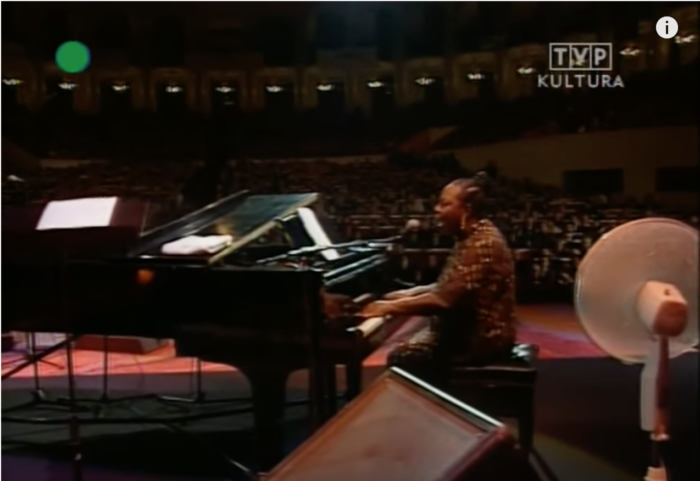
Still image from recording session: Live, December 18, 1997 in Warsaw at Kongresowa Hall. Nina Simone performing “Pirate Jenny”
✺✺✺
Okay, one more story. I want to talk a little about Worksongs.
In my reflection on the period of the violent enslavement of Black people in this country, I often look to their artistry during this time, and I see the medicine in spite of their forced labor. I do this in remembrance of ancestral labor.
Boat songs regulated rowing or poling boats in coastal and inland waters–a practice that had been reported before 1800 and such reports continued throughout the antebellum period. “The boats were rowed by slaves, who seemed to feel that the reputation of their masters depended on their skill in rowing and singing, for they invariably sang as they rowed.” These songs use the voice to support forced labor as a way to carry through, commune together, and survive.
The Worksong is a recurring genre in the African Diaspora. From “I’ll Be So Glad When the Sun Goes Down” to “Make It Work Again” as featured in Jingle Jangle to Rainbow ‘Round my Shoulder by Donald McKayle, Black people will make a fire song about the fucked-up labor they are doing. And in the enslavement period in this country, there were a lot of specific work songs by Black people because of well…the tremendous amount of work. We had corn songs, boat songs, grinding hominy songs, and so on and so on. So when a white passenger requested “Round’ de Corn, Sally,” a corn song, on a boat she wrongly conflates all Black music to be the same.
The medicine in this Black artistry is in its flexibility. Recognizing that it’s a corn song on the boat, they had to sing it slower to row to. The elasticity of the tempo is how we will make it support our needs. Brilliant.
I wonder how a rogue wave would fare against a boat with Black singer-rowers on the inland rivers along the eastern seaboard or the Mississippi. Maybe a group of salvors would come. I imagine my people would sing through it and get to the other side.
Cargo.
Capital.
Humans.
Transatlantic slave trade.
My body.
All of our bodies.
Listen to Recording of “The Plantation” Ballad or “Sold off to Georgy”
✺✺✺
An incredible writer, Anna Tsing, penned the following:
“Many preindustrial livelihoods, from foraging to stealing, persist today, and new ones emerge, but we neglect them because they are not a part of progress. These livelihoods make worlds too—and they show us how to look around rather than ahead.”
I quote her because all three of the above stories are stories of anti-progress. Rushing to progress is what has gotten us into this mess, and listening to the pause just might make tomorrow bearable.
- “How to Rescue the World’s Biggest Cargo Ships.” BBC Future, BBC, https://www.bbc.com/future/article/20220530-how-to-rescue-the-worlds-biggest-cargo-ships?utm_source=pocket-newtab.
- Nina Simone: Pirate Jenny, YouTube, 7 Feb. 2013, https://www.youtube.com/watch?v=K0voUEM2mE8. Accessed 11 July 2022.
- Epstein, Dena J. “Chapter 9, Worksongs.” Sinful Tunes and Spirituals: Black Folk Music to the Civil War, University of Illinois Press, Urbana, 2003, pp. 167–170.
- Ibid. pp. 167
- Tsing, Anna Lowenhaupt. The Mushroom at the End of the World: On the Possibility of Life in Capitalist Ruins. Princeton University Press, 2021.
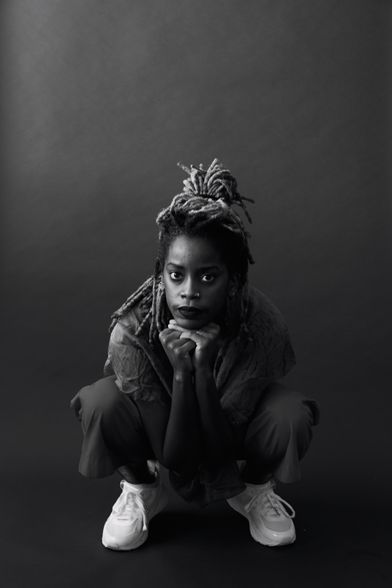
Photo of Angie Pittman by Whitney Browne. Angie is crouching down in a deep squat with her fingers interlaced and her head is resting on this joined fist. In a black and white photo, She is looking directly at the camera.
Angie Pittman is a New York-based dancer-choreographer. Angie’s work resides in a space that investigates how the body moves through ballad, groove, sparkle, spirit, spirituals, ancestry, vulnerability, and power. Her work has been performed at The Kitchen, Gibney, BAAD!, Movement Research at Judson Church, Triskelion Arts, STooPS, The Domestic Performance Agency, The KnockDown Center, The Invisible Dog(Catch 73), The Chocolate Factory, Danspace Project, and Roulette. Angie has had the pleasure of being able to create collaboratively with A Sef, Jasmine Hearn, Jonathan González, Athena Kokoronis, and Anita Mullin. She holds a MFA in Dance and Choreography from the University of Illinois at Urbana-Champaign with a graduate minor in African American Studies and is a certified Professional teacher of the Umfundalai technique. Her choreographic work has been supported by Foundation for Contemporary Arts Emergency Grant and residencies through Tofte Lake Center, Movement Research, New Dance Alliance Black Artists Space to Create, and Djerassi. As a dancer, she has danced in work by Larissa Valez-Jackson, MBDance, Ralph Lemon, Tere O’Connor, Cynthia Oliver, Anna Sperber, Donna Uchizono Company, Jennifer Monson, Kim Brandt, Tess Dworman, Antonio Ramos, C Kemal Nance and many others. As an educator, she has taught at Brooklyn Arts Exchange, Movement Research, MoMA, Sarah Lawrence College, Marymount Manhattan College, and is currently an Assistant Arts Professor of Dance at NYU: Tisch School of the Arts.
Website
angiepittman.com
Instagram
@angellaellaella
Facebook
Angie Pittman
Support
Venmo @Angela-Pittman-1
Paypal @angiedpittman@gmail.com
Hi.
I am so glad you are here, reading or listening to this.
As we begin, I would like to invite you to take a moment to yield your attention to your internal experience—specifically, the experience of your thinking self, your feeling self, and your sensing self.
Let us begin with the sensing self.
Where are you right now? What is your body’s posture or position? What is your breathing like? What’s your body’s temperature? Where are you holding and how strong or light is your weight? Can you identify physical sensations, possible places of tension, of comfort or discomfort? Are there any body parts that are immediately noticeable or some that you cannot feel or access at all?
Scan your general energy level. Does it match and feel aligned with your current activity? If not, how can you modulate your current activity to honor and match your body’s energy?
Pause here for a moment… then, gently, let that go.
Next, bring your attention to your feeling self. What emotions can you identify as part of your experience right now? What is the overall quality and intensity of your emotional landscape? Where in your body are you experiencing those emotions? If you cannot label them, don’t worry. Just connect again to your physical sensations and see if they point to an image, to a memory, or to a specific feeling.
And then, gently, let that go.
Finally, bring your attention to your thinking self, your mind. What is the quality of your thoughts right now? Are they zooming at high speed and shouting directives at you with force? Or are they gently flying by as soft whispers, the meaning of which you can’t really make up? Or somewhere in between? Does your head feel crammed, heavy, or hot? Does it feel light, cool, spacious?
Again, gently, let that go.
These, our sensorial, emotional, and thinking selves, are the three primary levels of awareness through which we absorb, filter, and make meaning of our experiences.
We’ve just practiced what I call Embodiment: bringing conscious awareness to the continuum of Body, Mind, and Emotion.
Take a moment and check in with yourself. Which of these selves was easiest to access? Which felt the most familiar to you?
Some of us analyze, internalize, and respond mainly through our rational brains, what we call our mind. Others process through their emotions, allowing their feelings to be the main source of interpretation of and response to situations they encounter, whereas others tend to their bodies and physical sensations, responding primarily in physical action.
Each of us has a preferred or default entry point to making sense of experiences. Hence, we often inadvertently—and usually unconsciously—ignore signals and relevant information sent from other levels of awareness. These preferences are informed by our personal histories, as well as our natural predisposition and personality. Interestingly, many of us may go through life without ever really identifying which of these levels of awareness we prioritize in our everyday lives.
I first confronted this reality when I began my training to become a Dance/Movement Therapist. I entered my Masters program confident in the many rich years I had spent as a professional dancer, convinced that I was a very “embodied” person. After all, I told myself, how could I not be? Had I not just spent my entire life in the pursuit of movement, honing my body’s physical abilities and expression? I felt sure I possessed deep embodied knowledge.
Yet, I quickly learned I was not, in fact, embodied. Not if embodiment requires attending to our different levels of awareness—physical, emotional, and mental. Not if embodiment means tending to the aware self as whole, pregnant with information about our physical, emotional, and mental states. Not if embodiment, then, means a strong advocacy for self.
If all of these are true, I was not embodied.
Much to my own chagrin, I saw that overtime I had instead mastered the art of shutting off many of the messages that I was receiving, and that I had an arduous time identifying (let alone listening to) what was going on, especially in my body.
What I came to realize from my own experience and observing that of others with similar backgrounds, was that dancers, specifically professionally trained dancers, are in the body, but not embodied.
Like sports athletes, dancers are exquisitely trained to perform on command. This is often done and often only possible, however, through numbing of physical sensations (i.e. pain, exhaustion, injury), as well as emotional response, and thoughts.
Dissociation is the path of least resistance for many professional dancers. That’s how we survive the intense requirements of training, techniques, long hours, demanding and sometimes abusive teachers and choreographers, and the absurd expectations that this field places on bodies, minds, and emotions.
Shutting out more and more awareness as we pursue our craft, dancers actually become strangely disembodied, turning the notion of “embodied dancer” into an oxymoron.
When I dove into my DMT training, I was confronted with this stark, self-shattering and humbling realization. However painful, it marked the beginning of a slow, painstaking but deeply necessary reframing and repatterning of my relationship to myself and to dance as a whole.
Most of us enter dance at a young age because it brings us joy. Dance—a primal human pursuit—engenders healing, community, happiness, catharsis, pleasure. And yet, as with other things tainted by capitalism and colonialism, dancing has instead brought pain to many professionals. It starts so pure yet becomes dysfunctional when we silence parts of ourselves in the hope of dancing, dancing, dancing all day and night. But isn’t that what we wished for all along? How, and where along the way do we lose ourselves? What systems and structures lead to this departure from the authentic self?
As I healed my own relationship to dance through DMT, I heard loud questions arising within me. What if I had been offered these practices from the beginning? What if dancers were trained with respect and honor befitting their full humanity and building their sense of agency and embodiment, instead of bodies picked to reflect narrow ideas of aesthetic value and pleasure?
How much pain could be avoided! How much joy and pleasure could be preserved, even increased! How much bountiful creativity and performance prowess could be accessed from this place of freedom, wholeness, and permission! And how many talented people could we save from burnout or injury!
We must focus on restoring joy and pleasure as practices of agency and ownership. We must reclaim our own power over our bodies and embodied well-being. We must dismantle abusive, profit-based, capitalist, colonialist expectations that have brought harm to the Western dance world for centuries.
This inspired my mission to bring the tools and practices of DMT to the professional dance community, as I know them to be incredibly effective and accessible to dancers.
I seek to offer space for healing where the pain and disconnection begin. My fervent hope is that with intention and attention we can begin to reshape how we approach, teach, and make dance, providing a healthier and more sustainable environment for the young dancers of today who will become the choreographers and teachers of tomorrow.
I would encourage those who believe art is born of suffering and genius derives from breaking boundaries and disrespecting limits (of self and of others), to reconsider. Let us all ask ourselves where we got these ideas. Are we unknowingly perpetuating internalized, intergenerational pain and trauma? Are the structures we live in supportive of our embodied well-being and sovereignty, or are they designed to control and diminish?
Let us see what happens when we allow ourselves and others to practice art and creativity that are born of joy. Art and creativity that are born of freedom. Art and creativity that are born of love. Even if the subject of our art (or of the art of someone else that we are a part of) is something that is sourced from painful experiences or addressing dark realities, access to our creative genius can’t help but be enhanced when we are moving, and being allowed to move, from a place of embodiment, respect, agency, freedom, and permission.
We have a lot of work to do, and it is time to do it.
I don’t have all the answers, but I am ready to ask the questions.
I hope you will join me.
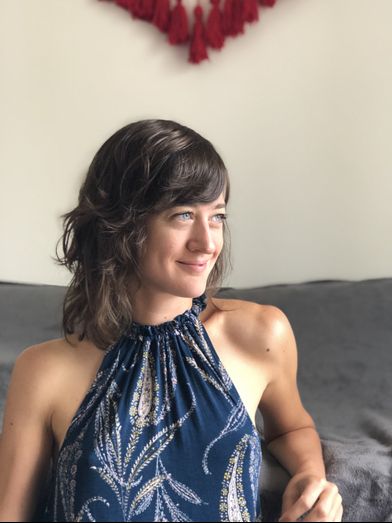
Photo of Giulia Carotenuto, courtesy of artist. Giulia is wearing a blue halter top patterned with leaves, smiling, with her head turned to her left, framed by a grey couch and knitted red tassels against a white wall.
Giulia Carotenuto is a Rome-born, US-based Dance Movement Therapist, Facilitator, and Performer, who has committed her entire life to the study of movement. Her life in dance began as a traditionally trained dancer, eventually leading her to perform in a wide variety of styles and forms, touring nationally and internationally with artists including Faye Driscoll, Monica Bill Barnes, Pavel Zustiak, and Third Rail Projects. After suffering a profound period of burnout and discovering the need to reconnect to and heal the roots of her relationship to dance (and herself), Giulia left NY and the professional dance world, and went on to study Dance Movement Therapy (DMT), earning a MA in DMT from Codarts University in Rotterdam (NL). Giulia believes that our bodies hold many secrets, and that exploring our own movement in a supportive and healing environment can tell us who we intrinsically are at our core, bringing forth the possibility for change. As an Artist and Dance Movement Therapist, Giulia is committed to providing the setting for a safe exploration of histories in movement, and the innate threads of expression and impression that exist between humans as a result of our individual and collective body stories. Giulia seeks to investigate how these stories are held, told and heard, investing in an authentic, supportive, vulnerable and healing relationship between bodies in movement. Taking inspiration from her own history, and seeing how that history is unfortunately all too common in the professional dance world due to the many stressors, oppressive environments, and sometimes even traumatic settings that color it, Giulia has committed herself to offering a different perspective, one that includes the incredible tools of Dance Movement Therapy as inherent part of professional training and performing. In doing so, she is committed to fostering a more embodied, just, inclusive, caring, sustainable, and healing approach to dance.
Website
www.healingdanceandmovement.com
www.giuliacarotenuto.com
Instagram
@giules85_dmt
Support
Venmo: @Giulia-Carotenuto
PayPal: carotenuto.giulia@gmail.com
Puerto Rico-born and Brooklyn-based director/choreographer Antonio Ramos (AKA “Mama Bear”) has been a treasured fixture of New York’s downtown performance scene since the early 2000s, creating a substantive body of work to—in his own words—“fabricate gloriously chaotic performances from shiny lies, physical hyperbole, and naked flesh in an attempt to find the glitter trail to truth.” In recent years, he has gained visibility through works such as Neverland (2012), created during a year-long residency in East Harlem’s El Museo del Barrio; Mira El (2015), developed through Movement Research Artist-in-Residence (AIR) program and presented at the Center for Performance Research and Abrons Art Center’s American Realness Festival; Almodóvar Dystopia (2017), commissioned and premiered at New York’s Dixon Place; and the current multi-part opus, El Pueblo de los Olvidados (The Village of the Forgotten), a devastating examination of his native land post-Hurricane Maria, of which the first installment was presented in 2019 at The Chocolate Factory.
Ramos’ work is a highly theatrical, outré, rousing celebration of queer culture and America’s diversity. This article intends to provide neither linear nor definitive analysis of his recent oeuvre: instead, it offers a few reflections on the aesthetic and political dimensions of his complex body of work for the stage.
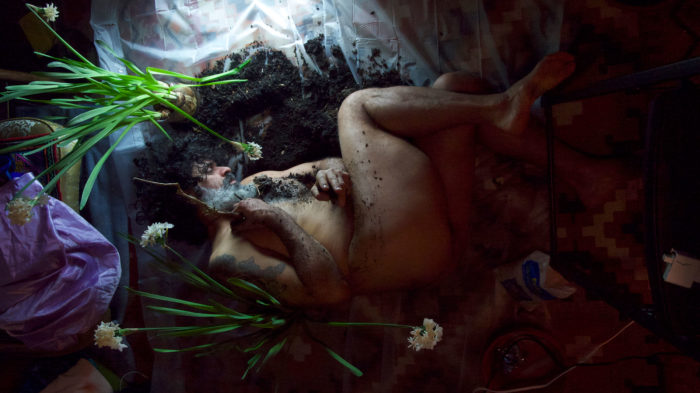
A bird’s-eye view of a nude Latinx male with curly dark hair and salt-and-pepper beard, lying in a pile of dirt strewn on top of a sheet of translucent plastic, and surrounded by white flower plants.
#BodyPolitics
Ramos’ body of work has extensively explored the use of nudity. Indeed, El Pueblo de los Olvidados is performed in the nude almost in its entirety, as has been the case with his recent productions. What is striking about Ramos’ use of the naked body—his own and others’—is his facility with taking his audiences along for the ride–and well past their comfort zones.
And yet, Ramos intends his work to reach a wide audience. He has said: “[My work] is not intended for a singular audience of a particular race, gender or disciplinary preference, but a colorful, multicultural and multigenerational public, for public spaces as well as museums, galleries and venues at large.”
Indeed, naked bodies of his stage space vary in gender, race, shape, size, and ability. He manages the rare feat of creating a level playing field for audiences’ benefit: it is refreshing to see a liberated body, not one that has been objectified or sexualized. Deeper into the performance, the viewer’s gaze gradually acclimates to regard the body without the preconceived dictates of socio-cultural norms; the work simply transcends them. Bodies of Ramos’ ensemble appear unmoored from the constraints of stale, codified definitions of beauty. Nudity in his work deals with the representation of body in its natural state: it is simply what it is, presented without prejudice or commentary.
#Language
Almodóvar Dystopia is performed primarily in Spanish, a nod to the oeuvre of the titular cineaste. I found it quite obvious that spoken language was not intended as the primary vehicle for conveying meaning in this work; indeed, it was intentionally distorted and obliterated. Still, this aspect of the production drew a great deal of criticism during its world premiere engagement at Dixon Place. In her Village Voice review, Elizabeth Zimmer described the production as: “Rambling (…) It includes much talking in Spanish (only occasionally graced with subtitles, which even my rudimentary comprehension of the language let me understand were less than accurate).”
I find it unfortunate that some viewers egregiously missed the point. Ramos and his team invite the spectator to experience the effect of Almodóvar Dystopia without relying on the conventional narrative to parse for meaning, using the Almodovar reference as a springboard for a broader exploration of queerness. Furthermore, let us consider that Spanish is the second most spoken language in the United States of America, with over 40 million people speaking Spanish as their first or second language. Ramos’ production cleverly—albeit indirectly—questions the hegemony of the English language within an increasingly multicultural landscape of United States demographics. Indeed, according to Pew Research Center, by 2055, the US will not have a single racial or ethnic majority.
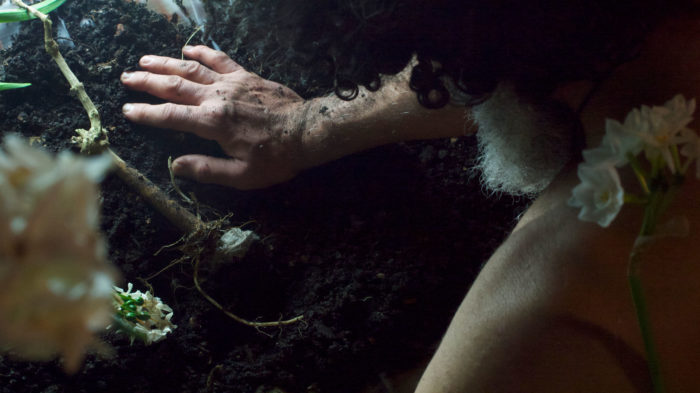
A nude Latinx male with curly dark hair and salt-and-pepper beard is gazing down on a small uprooted lying on a patch of dirt, while a white flower is resting on his shoulder.
#Hybridity
Ramos’ productions are genre-queer. While he is often described as a choreographer—and there is indeed a great deal of choreographed movement involved—his productions are highly theatrical, and multiple disciplines are represented with equal weight. The work relied a great deal on his frequent collaborator Alex Romania’s layered video design, with the abundant use of green-screen and a great deal of live-feed action. Romania often incorporates his colorful, kaleidoscopic designs into the projections, creating vivid visual backdrops for Ramos’ mise-en-scène. Similarly, the sonic environments Ramos deploys in his work contribute greatly to the surrealist atmosphere of his shows with trippy, repetitive, heavily sampled tracks.
One of the most outlandish, and definitely most surprising, dimensions of his work, featured in Almodóvar Dystopia, is culinary in nature—the fruit of an intimate collaboration between Ramos and the self-described “rogue chef and cultural epicurist” Miranti, aka Dame Cuchifrita. I was pleasantly surprised to have a performer kindly offer some curiously textured (and deliciously flavored) chocolate bonbons mid-performance. As I was savoring the sweet, an educational—and equally hysterical—”making-of” video rolled in the background, showing the fearless chef capturing a mold of Ramos’ anus to create a cast for the truffles served during the show. Kudos to Ramos and Dame Cuchifrita for taking “ass candy” to a (w)hole new level!
#Source
Ramos’ relationship to his source material fascinates me. Created as science-fiction, El pueblo de los Olvidados’ choreography was prompted by his research about Puerto Rico in the wake of Hurricane Maria. The narrative concerns the protagonist, Tony Tacon, returning to his native planet devastated after years of colonization by the alien species, FIMA.
Unbeknownst to the native population, the purpose of this invasion was to turn the native people, Tainos, into Barikas (word play between denigrating term for gays, “Marica,” and the indigenous name of the island of Puerto Rico.) FIMA transforms the nation into an intergalactic tropical resort, while secretly planting invasive species to take over the nation by destroying its natural habitat. The infusion of alien flora and fauna gives rise to a new, diverse, trans-sexual species with multiple mammaries and sexual organs.
This allegorical work references the gringo invasion of Ramos’ native land. It reflects on the dilemma of an artist in the diaspora, away from his island, exploring themes of colonization—its power and the rampant abuse of that power.
Similarly, in Almodóvar Dystopia, Ramos’ approach was not naturalistic, but rather more aligned with abstract impressionism. While scripts from Almodóvar’s films were quoted in certain sections of the show, their meaning was often disrupted, obscured or obliterated by the sound design and intense visuals. Still, Romania’s patterned projections referenced the color schemes of Almodóvar’s films, and Admanda Kobilka’s sonic landscapes often looped samples of Almodóvar’s soundtracks. During the rehearsal process, Ramos encouraged his performers to explore Almodóvar’s characters simply as a jumping-off point for mining their own personal histories.
Fascinatingly, in spite of Ramos’s successful effort to stray from direct quotation in favor of the ripple effect, the production was nonetheless imbued with a hauntingly Almodóvarian atmosphere—one could say a refraction, rather than a recognizable reflection of its source.
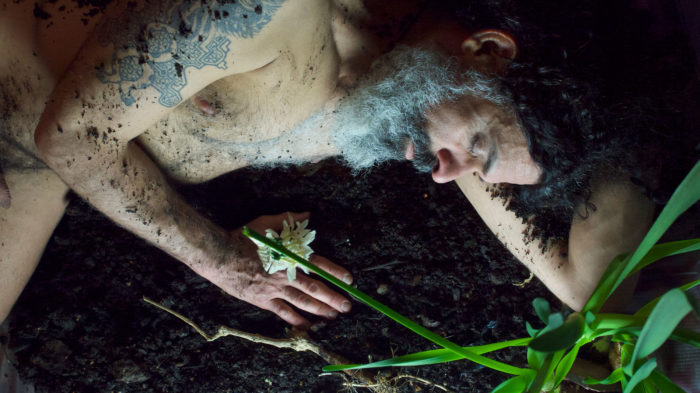
A nude Latinx male with curly dark hair and salt-and-pepper beard is peacefully lying in a patch of dirt with his eyes closed, holding a white flower in his hand.
I would like to wrap up these ruminations with the artist’s own words. In a 2017 interview I conducted with Ramos, he said: “I employ my personal Queer-Puerto-Rican-Cha-Cha-Heels-Shaman identity as a point of departure. Working closely with my dancers, I created exaggerated personae, exposing them to challenges and anxieties conjured by dance-making process. The dance emerged from the process of colliding these characters up against each other in an environment full of glamor and decadence.
“My work creates an umbrella for abstraction and queerness in our dance community. (…) I am interested in remapping the definition of beauty beyond what is being presented as such on a daily basis, in envisioning possibilities for alternative intimacies, and for radical empathy. I wish to continue inventing creative solutions to provoke thought and action around how we can be with each other, and exist in the world that everyone belongs to.”
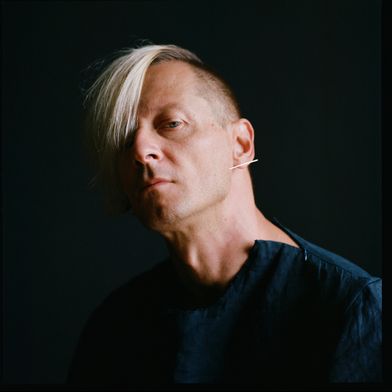
Photo of Ivan Talijančić by Maria Baranova. Image shows the author of the article, a fair-skinned male with light blond
hair wearing a dark top against a black background.
Ivan Talijančić is a queer immigrant time-based artist and cultural producer, working at the intersection of theater, dance, film, installation art, new media, journalism, curatorial work and education in New York and around the globe. As a co-founder of the multidisciplinary art group WaxFactory, his work has been presented at numerous venues and festivals stateside and worldwide, including Lincoln Center (NYC,) ICA/Institute of Contemporary Art (London), Centre Pompidou (Paris), Gulbenkian Museum (Lisbon), Zürcher Theater Spektakel (Switzerland), Sonar (Barcelona,) Cankarjev Dom (Slovenia,) Adelaide Festival (Australia,) among others. He has been awarded fellowships and residencies at Akademie Schloss Solitude (Stuttgart, Germany,) Bogliasco Foundation (Genova, Italy,) Emily Harvey Foundation (Venice, Italy,) Hermitage Artist Retreat (Manasota Key, Florida,) Marble House Project (Vermont) and elsewhere. As a journalist, he regularly contributes to publications as BOMB Magazine, Brooklyn Rail, etc, and is a current member of the selection committee for The Bessies / the NY Dance & Performance Awards. Ivan teaches extensively in the US and abroad. He is the founder of CPP/Contemporary Performance Practices summer intensive in Croatia and is currently a professor at Carnegie Mellon University’s John Wells Directing Program. He holds an MFA from Columbia University School of the Arts.
Website
www.waxfactory.nyc
Instagram
@waxfactory.nyc
Twitter
@waxfactory
Facebook
@waxfactoryNYC
Support
Venmo: @talijancic
Prologue
My talent would never be enough in a world that values white, straight, wealthy, non-disabled bodies. Then I was reminded of my first year of high school when my creative writing teacher taught me an essential lesson about honing your craft as an artist.
She told us during our first week in our performing arts high school that she could teach us the craft of writing but that she could not teach us talent. She once shared this quote with us: “You either have talent, or you don’t,” but she’d also admit we did have talent because, after all, we were accepted into the school.
It’s been 15 years since that day in high school, and her advice has stayed with me, reminding me that honing your craft is one of the most important aspects of being an artist. I was never the most talented writer, dancer, or choreographer, but I was always one of the most hardworking artists in my high school class. My grit, passion, and unwavering commitment to my art forms have been essential to my success. When people tried to tell me that I had to choose between writing and dance, my stubbornness proved to be one of my greatest assets. My desire to become a professional artist was fueled by a desire to get out of my hometown.
My Story
The ground where I stood trembled beneath my feet, warning me that this intersection might be my last. For a Brown disabled queer kid, imagining a world outside of blood-stained concrete seemed far-fetched. Where does a kid with no compass go, with no examples of who he could become?
I grew up in America’s first industrial city, Paterson, New Jersey. While my hometown may be known for silk production, the movie Lean On Me, and hometown celebrities like Victor Cruz and Fetty Wap, it is also the fourth most dangerous city in New Jersey. While growing up, I often wondered if I would make it to the other side. Would I ever make it out of my hometown? Or would I fall victim to poverty, addiction, and the never-ending violence surrounding me?
Like many kids who grew up disabled and unable to participate in physical activities with their classmates, I found solace in my notebook. Growing up in a predominantly Black and Brown community, I didn’t have to worry about my skin color or last name. But my gait, my inverted legs that I often stumbled over, taught me early on that I did not belong.
When I was in the third grade, my classmate Nathan called me a “freak” during breakfast time in the cafeteria. I was humiliated, and I remember my face turning red and my chest tightening. That moment during breakfast taught me that although we were both men of color living in Paterson, I did not belong because my disability made me different.
I would go on to learn to embrace my disability and see it as an opportunity rather than a limitation. My creative life began to form while I was still in high school. There, I created marked dance project (MDP), in 2009, a contemporary dance company for disabled and non-disabled dancers. I made history by being the youngest person in the United States to found and artistically direct a dance company that was physically integrated. My work in the dance field would eventually take me all over New Jersey, Philadelphia, New York City, and California.
My dance company served as the vehicle for my dreams. I got to work with folks like Marinda Davis, Tyce Diorio, Todrick Hall, Judith Smith, Marc Brew, and Stacey Tookey. I wish I could tell you that the road to my artistic career was a clear path, one without struggle and obstacles, but that isn’t how life works.
When I started MDP, teachers and strangers told me I did not have what it took to make it as a dancer and artistic director. I wasn’t talented enough and was too young, lacking experience. But besides being one hell of a stubborn person, I truly believed in my calling and knew that I survived my premature birth at five and a half months because my calling was more significant than any doubt others and myself may have had.
Recently, I watched Halftime, a Netflix documentary about Jennifer Lopez and the journey she took to become a headline performer at the Super Bowl. A fellow Puerto Rican artist from the Bronx, who, like me, grew up in poverty and was constantly told that she had to choose between her art forms because she “couldn’t do it all,” would become one of my greatest possibility models.
For decades, Jennifer has heard that she was not talented or good enough despite her commercial success as an artist and her work as an entrepreneur. As I saw the documentary, it triggered my pain as I reflected on how I built a life and career despite the constant messaging that I was not enough or that my work wasn’t good. I did not expect to cry, but the tears were a needed reminder that I endured and overcame the odds to become a professional storyteller. I am creating stories through various mediums because I don’t want other disabled queer kids of color to feel alone and isolated. After all, so few stories reflect our lives at those particular intersections. I want them to see me and my work and know the possibility for their own lives and dreams of becoming artists.
Epilogue
While so much of my community’s history lies in the cracks of the pavement—where others barely notice– I see, feel, and understand the pain between the lines of our intersections. The blood that fell through the cracks, the cries for help ignored, the ground in which I walked as a child may have been stained, but I wouldn’t be where I am today had it not been for those intersections, for I am just one rose that grew from the concrete.
So, no matter what corner you find yourself in, know that the courage it takes to be yourself and cross the street is the same courage it takes to enter rooms that others have deemed you unworthy of entering. Be you, and know that authenticity is a daily choice worth making if that means you get to be your true self. Authenticity may not get you into every room, but it will make the rooms you enter better because you bring your whole self to the table. Your calling is greater than any doubt others may impose on you.
When Jennifer Lopez won the ICON Award at the iHeart Radio Music Awards, I was moved by her acceptance speech. I remember she said, “I can overcome negativity, and so can you, and let me tell you something else, I’m just getting started.”
My 17-year-old self might be shocked to see me now! Award-winning storyteller who has spoken at Harvard. Master class teacher at Juilliard. I’ve given a TEDx Talk and various talks around the globe. My work has made the dance sector more inclusive.
I look back at that 17-year-old and say, “You made it. Through unwavering commitment to craft, through belief in yourself, you made it.”
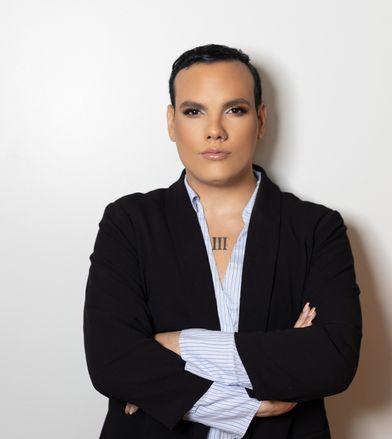
Photo of Mark Travis Rivera by Jen Diaz. Mark, a light brown femme-presenting man with short black hair and make-up on, is posing with his arms crossed against a white wall and is wearing a black blazer and a light blue pinstriped dress.
Mark Travis Rivera is an award-winning professional storyteller––telling stories is at the core of Mark’s purpose in life. A graduate of William Paterson University, he earned a bachelor’s in women’s & gender studies with a minor in public relations. In 2013, Rivera received the Student Government Association’s Lifetime Achievement Award for his commitment to the William Paterson community. In the same year, he was honored with the Campus Pride Voice & Action Award for his work with the LGBTQ community. He recently won the Audre Lorde Award for Social Justice from John Jay College of Criminal Justice, CUNY, and the Lavender Legacy Award from William Paterson. Rivera is the youngest person to found an integrated dance company in the United States; marked dance project (2009-2019), a contemporary company for dancers with and without disabilities, made its debut at Rutgers University. After ten years, Rivera dissolved marked dance project and is now an independent disabled choreographer. Rivera’s writings have appeared in The Bergen Record, Herald News, The Star-Ledger, Fox News Latino, and The Huffington Post. As a speaker, he has spoken in front of crowds at various institutions of higher learning, including Harvard, MIT, and NYU. His TEDxTalk, “Embracing Yourself, Embracing Your Potential,” was a smash in 2014 at Bergen Community College. His debut collection, Drafts: An Imperfect Collection of Writing, was published in August 2017 through Amazon. In 2020, Rivera launched his wellness podcast, Marking The Path, available on Apple Podcast and Spotify.
Website
www.MarkTravisRivera.com
Instagram & Twitter
@MarkTravRivera
Support
CashApp: $mtr91
As I write this introduction in June 2022, it’s nearly one year since I and many others took a slow walk with artist Okwui Okpokwasili, as part of Miguel Gutierrez’s Processions series (2021). After many different versions of lock-downs, much of the world has since re-opened, but the loss of life due to Covid-19 continues. Being outside for performance is still an option that brings relief from anxiety as well as exciting opportunities for theatrical choreographers to engage audiences differently. Okpokwasili’s offering still resonates with me in a very particular way. The moment I think of it, I become aware of my breath and it relaxes and elongates. I remember the friends with whom I shared that evening, and the strangers who ventured to hold space with me. Participating in the performance left a visceral trace unlike anything I’ve experienced as a seated audience member. The sensations of the temperature of the air, of watching everything with a wide gaze while being seen, and of being intimately together, are all very present in my body today.
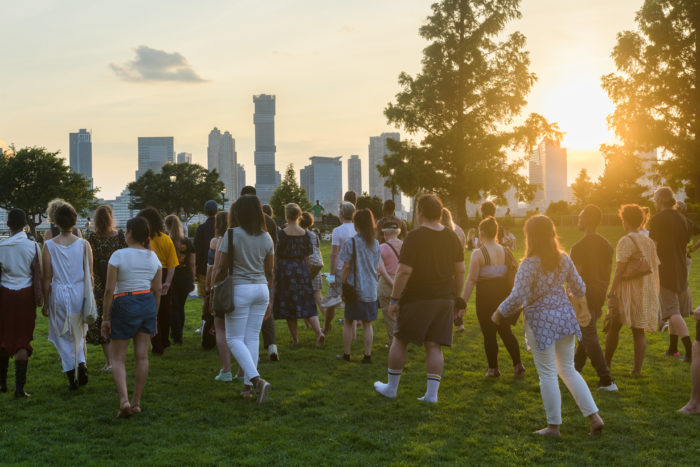
Photo of a group of about 26 adults walk towards the waterfront in Rockefeller Park as the sun sets by Ian Douglas
When I arrived at Rockefeller Park, the event had already begun. Rather than rush to find a spot to watch, I slowed and slowed down again until falling into a comfortable place in the procession. My eyes spotted Okwui Okpokwasili’s tall, slender frame, her ebony skin contrasting with that of those around her.
At first, I questioned what appeared to be the appropriation of a Zen Buddhist walking meditation into a performance context. Then I wrestled with the distinction between ritual and performance. If all performances are rituals, are all rituals subject to the mores of theatrical performance? These questions were part of the conceptual landscape that structured my experience of the work, though as I became a part of the procession, the questions faded away, and I turned to listening.
Okpokwasili and Emilý Æyer’s vocalizations called us in like a siren song. Some of us with our shoes in our hands, some of us carrying bags, some of us with pigeon toes, some of us with swollen ankles; we collectively committed to walking as slowly as we were able, to keep in the rhythm of the artists.
Holding my sandals, I allowed my feet to be carried by the manicured lawn. Immediately the prior hustle of my day was erased, and the calm cracked me open. Tears welled in my eyes with no warning from my heart. I looked at the Hudson River and simultaneously at the thirty or so people around me in the procession, and many more enjoying a warm evening. Very quickly and with surprising ease, all of the stimuli of a New York City summer transformed into a sort of white noise—an absent presence.
The city had recently lifted its outdoor mask mandate with 70% of the population fully vaccinated. Still, knowing we were not out of the woods yet, some of us wore masks, some did not. Some, like me, removed our masks but kept them dangling from our fingertips, signaling that strange limbo between feeling safe and dangerously vulnerable…perhaps a little distrustful of the honor system used to re-open the city.
As I began to focus on my fellow participants in the processional, I noticed how we all mimicked Okpokwasili’s forward gaze. I wanted to challenge this “concert dance” habitude of following the “leader,” but without disturbing our collective focus. I chose to gently shift my head to observe all of the elements in my peripheral vision.
Beneath me, a woman of Asian descent lay on her back in the grass with a small dog at her side. She closed her eyes and over the course of probably half an hour allowed a group of strangers to wash over her, moving gently around her and the dog. Whereas most site-specific work I’ve seen tends to intimidate onlookers who often shuffle aside to make way for the performers, she stood her ground, or rather, let it lay. I admired her surrender as well as her innovative and perhaps rather bold claim of space.
Our weighted steps were mindful and drove us forward. These steps felt purposeful and yet their conviction was entirely unnamed. We held no signs, and we chanted no slogans, but we were an unmistakable echo of Black Lives Matter, Stop Asian Hate, and Protect Trans People—the movements that had dominated the streets, parks, and plazas earlier that summer.
Over time, my shoulder began to cramp under the weight of my bag, but like everyone else, I was committed to the collective effort. I gingerly moved the bag over to my other side and snuck in some slow-motion shoulder rolls as we proceeded. Being a trained dancer, I was enticed to do more than just walk, especially when the sound-score shifted, which it did several times.
As the beautiful soft singing and percussive recording guided me, I felt the energy of our collective procession relax my breath, and the impulse to make more expansive, improvised movements would bubble up. But I knew that to do so would place focus on me, rather than we, so I allowed the silent walk to be our dance.
I scanned the horizon with my eyes and realized we were all performing—not only those of us in the procession, but those performing the roles of father, friend, exercise buff, or romantic partner. We all allowed ourselves to see and be seen, but no one was doing anything particularly spectacular. That’s part of what made it so stunning. Broadway is closed, baby. Let’s just be.
As we approached the final edge of the grass, Okpokwasili’s daughter torpedoed through the procession to tug on her mom’s arm and ask her something. The artist nearly fell over, briefly losing her balance while trying to respond. It was a child’s reminder that the park is their space, we just get to use it. It was a bit of comic relief not unlike the ones so many parents experienced over Zoom, as their homes became schools, offices, and playgrounds during periods of lockdown. This moment of disruption was actually a charming intervention reminding us to not take ourselves so seriously that we forget to listen to our children—and what better time to be reminded than during a global pandemic.
At a moment when New York City was just emerging from its long and nightmarish slumber to regain its vibrance, its joy, and its hustle, we gathered to slow back down. At one point, I thought we must look like zombies, but we were so clearly content that I think most people looking on would have understood that in this slow movement, something cathartic was taking place. We were given space to be at ease together.
During a time when the pounding energy of social justice marches seemed never-ending, and the assaults on our humanity kept returning and pounding us like the tides, there we were, sauntering, our naked feet fondling the grass. Rather than an escape from these crises, the procession was an invitation to reset.
We approached the Hudson as dusk fell over us and into us, the ripples in the water mirroring our varied but unified breathing. Walking in Manhattan without being in a hurry is a rare experience. It allowed us to attend to the lights in the buildings on the horizon as they began to twinkle on like fireflies. With trembling, persistent, gentle, and confident steps, we arrived and arrived and arrived at the water’s edge. Held by the city that never sleeps, we rested.
- Okpokwasili is an Igbo-American multi-disciplinary artist and MacArthur Fellow. Her contribution to Processions, a series of three outdoor processions curated by Miguel Gutierrez, was presented by the Lower Manhattan Cultural Council in partnership with Battery Park City Authority and Movement Research. Okpowasili’s collaboration with musician Emilý Æyer, took place on June 20, 2021 in Rockefeller Park.
- After reading a draft of this essay, Okpokwasili’s collaborator Peter Born offered his response to this interpretation which I think is important to consider: “ It’s been interesting to hear people refer to what we were doing as an Asian-inspired or zen walk. It was meant to be an ‘empty vessel’ which could be filled in by any interior life. We were not attempting a meditation which is an action directed necessarily at the self and into the self. Instead, we focused on two things: 1. being present to every part of a step, every incremental muscle movement and shift of balance 2. having a soft focus of the eyes directly ahead in an attempt to awaken other ways of sensing the people walking with us rather than the visual, so that we could be walking with care and with each other. Ultimately, there is no ‘wrong’ way to do the activity or ‘wrong’ interpretation of the activity—I’m not saying your take on it was ‘wrong.’ We’re hoping that the structure of the activity allows everyone to just ‘be present,” and there’s no incorrect way of doing that.”
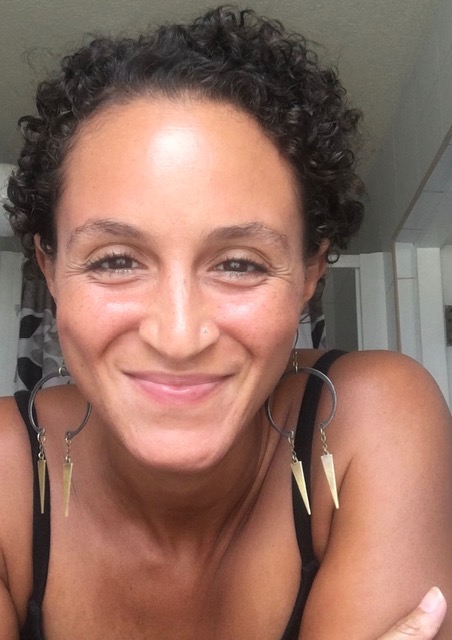
Photo of Rainy Demerson courtesy of artist. In this selfie, Rainy Demerson smiles at the camera. She has short, dark hair and dark brown eyes. She is wearing metallic earrings that hang near her shoulders and a black camisole.

Photo of Eva Yaa Asantewaa (she/her)
Image Description: In this selfie, taken in her home office,
Eva Yaa Asantewaa is wearing a black turtleneck sweater and
looking forward with a cheerful grin. She is a Black woman with luminous,
medium-dark skin and short gray hair. She’s positioned in front of a room
divider with an off-white basket-weave pattern.
Eva Yaa Asantewaa (she/her) is Editorial Director for Imagining: A Gibney Journal and, from 2018 through 2021, served as Gibney’s Senior Director of Curation. She won the 2017 Bessie Award for Outstanding Service to the Field of Dance as a veteran writer, curator and community educator. Since 1976, she has contributed writing on dance to Dance Magazine, The Village Voice, SoHo Weekly News, Gay City News, The Dance Enthusiast, Time Out New York and other publications and interviewed dance artists and advocates as host of two podcasts, Body and Soul and Serious Moonlight. She has blogged on the arts, with dance as a specialty, for InfiniteBody, and blogs on Tarot and other metaphysical subjects on hummingwitch.
Ms. Yaa Asantewaa joined the curatorial team for Danspace Project’s Platform 2016: Lost and Found and created the skeleton architecture, or the future of our worlds, an evening of group improvisation featuring 21 Black women and gender-nonconforming performers. Her cast was awarded a 2017 Bessie for Outstanding Performer. In 2018, Queer|Art established the Eva Yaa Asantewaa Grant for Queer Women(+) Dance Artists in her honor. In 2019, Yaa Asantewaa was a recipient of a BAX Arts & Artists in Progress Award. She is a member of the Dance/NYC Symposium Committee, Founding Director of Black Diaspora, and Founder of Black Curators in Dance and Performance.
A native New Yorker of Black Caribbean heritage, Eva makes her home in the East Village with her wife, Deborah. Sadly, their best-cat-ever Crystal traveled over the Rainbow Bridge on February 18, 2021.
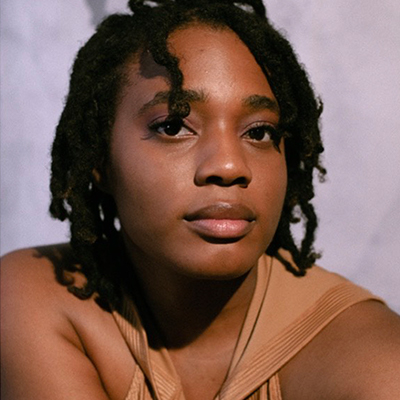
Photo of Monica Nyenkan by Jakob Tillman
Image Description: Monica Nyenkan is the daughter
of African immigrants. She has dark brown eyes and hair.
In this photo, her hair has two-strand twists.
Monica Nyenkan (flexible pronouns) is a Black queer artist, administrator, and emerging curator from Charlotte, NC. Graduating from Marymount Manhattan College, Monica received her Bachelor’s degree in Interdisciplinary Studies, concentrating on administration for the visual & performing arts.
Currently based in Brooklyn, Monica has interned and worked with Rachel Uffner Gallery, Gallim Dance, Ballet Tech Foundation, Movement Research, and 651 ARTS. She’s produced community-based engagements and art events throughout NYC for the last five years. She acted as a consultant and advisor to an award-winning project, LINKt: a dance film. Most notably, Monica co-curated WANGARI, a pop-up art exhibition focusing on climate change, with the Brooklyn-based collective Womanist Action Network.
Monica currently works as the Gibney Center Special Projects Manager, managing programs such as Black Diaspora and Imagining Digital. In her free time, Monica loves to watch horror films and spend time with friends and family.
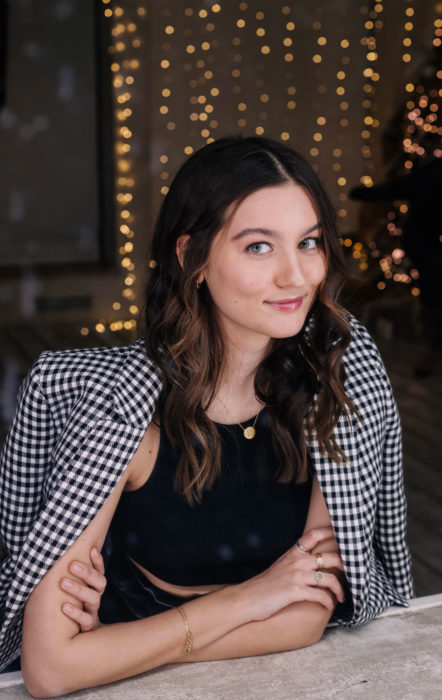
Photo of Anastasia Gudkova by Ksenia Ugolnikova. Anastasia is wearing a black top with a checkered blazer draped over her shoulders. She is a white woman with dark brown hair, wearing gold jewelry and light makeup. She is sitting down, leaning over a table with her arms crossed, and smiling into the camera. There’re string lights in the background of the photo.
Anastasia Gudkova (she/her), born in Moscow, Russia, is currently pursuing a B.A. in philosophy at New York University. While not a dancer herself, Anastasia has a deep passion and appreciation for contemporary dance and cultural programming and is fully dedicated to a future career in this sector.
Since 2019, Anastasia has worked as a Programming Assistant at MART Foundation, a non-profit, non-governmental foundation that supports contemporary culture on the international stage. Through this position, she has been exposed to a number of aspects of the performing arts world. Having worked on multiple projects both in the U.S. and internationally, Anastasia has been providing executive administrative assistance, events producing support, and logistics management.
Currently based in Brooklyn, Anastasia is a Gibney Center Presenting Intern since May 2022.
DISCLAIMER: Opinions expressed in Imagining: A Gibney Journal are the writers’ own and do not necessarily reflect the views, strategies or opinions of Gibney.